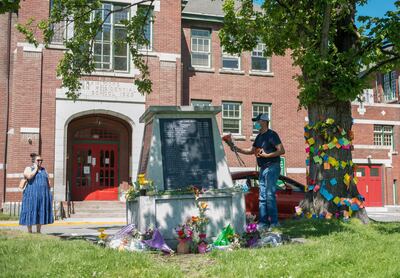Efforts were under way on Sunday to identify the remains of 215 children, some as young as three, who were found buried on the site of what was once Canada's largest Indigenous residential school – one of the institutions that held children taken from families across the nation.
The discovery has shocked Canadians and led to a period of national self-reflection on a dark chapter in the country's history.
Chief Rosanne Casimir of the Tk'emlups te Secwépemc First Nation said the remains were confirmed last weekend with the help of ground-penetrating radar.
More bodies may be found, because there are more areas to search on the school grounds, she said.
Earlier, she called the discovery an "unthinkable loss that was spoken about but never documented at the Kamloops Indian Residential School".
From the 19th century until the 1970s, more than 150,000 First Nations children were required to attend state-funded Christian schools as part of a programme to assimilate them into Canadian society.
They were forced to convert to Christianity and not allowed to speak their native languages. Many were beaten and verbally abused, and up to 6,000 are said to have died.
The Canadian government apologised in Parliament in 2008 and admitted that physical and sexual abuse in the schools was rampant.
Many students recall being beaten for speaking their native languages. They also lost touch with their parents and customs.
Indigenous leaders said abuse and isolation were the root cause of epidemic rates of alcoholism and drug addiction on reservations.
A report more than five years ago by a Truth and Reconciliation Commission said at least 3,200 children had died amid abuse and neglect, and it said it had reports of at least 51 deaths at the Kamloops school alone between 1915 and 1963.
“This really resurfaces the issue of residential schools and the wounds from this legacy of genocide towards Indigenous people,” Terry Teegee, Assembly of First Nations regional chief for British Columbia, said on Friday.
Forensic investigation
The remains were detected and not exhumed. Lisa Lapointe, chief coroner in British Columbia, said it was advised by the Tk'emlúps te Secwépemc on Thursday about the discovery of a burial site located adjacent to the former Kamloops Indian Residential School.
"We are early in the process of gathering information and will continue to work collaboratively with the Tk'emlúps te Secwépemc and others as this sensitive work progresses," Ms Lapointe said.
“We recognise the tragic, heartbreaking devastation that the Canadian residential school system has inflicted upon so many, and our thoughts are with all of those who are in mourning today.”
A radar specialist is continuing to complete a survey of the ground. It is anticipated that by mid-June a a full report will be ready. Ms Casimir said it would be shared publicly after first being disclosed to her band's membership and other local First Nations chiefs.

She said the band would also be looking into what it can do to repatriate the remains and honour the children and the families affected.
British Columbia Premier John Horgan said he was "horrified and heart-broken" to learn of the discovery, calling it a tragedy of "unimaginable proportions" that highlighted the violence and consequences of the residential school system.
The Kamloops school operated between 1890 and 1969, when the federal government took over operations from the Catholic Church and operated it as a day school until it closed in 1978.
Ms Casimir said the deaths were believed to be undocumented, although a local museum archivist was working with the Royal British Columbia Museum to see if death records could be found.
"Given the size of the school, with up to 500 students registered and attending at any one time, we understand that this confirmed loss affects First Nations communities across British Columbia and beyond," Ms Casimir said.
She said band officials were informing community members and surrounding communities that had children who attended the school.
The First Nations Health Authority called the discovery of the remains “extremely painful” and said in a website posting that it “will have a significant impact on the Tk’emlúps community and in the communities served by this residential school.”







